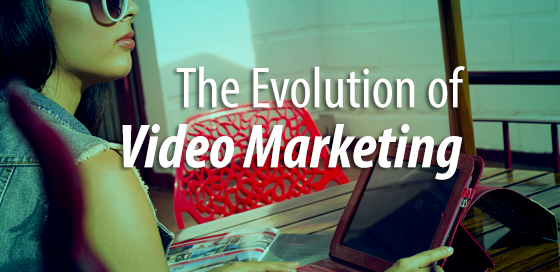As technology progresses, video becomes an increasingly popular form of online content. In the Internet’s early days, connection speeds weren’t high enough to make video content viable. Downloading a single clip would take hours. Now, however, we can watch an entire TV series on Netflix in Hi-Def, and have it load in the blink of an eye. YouTube is one of the most popular sites on the Internet, with hundreds of hours of content being uploaded and viewed every day. And, as with any trend, with video’s increasing popularity, video marketing has become more prevalent as well. Let’s take a look at how video marketing has evolved alongside this ever-improving technology.
A Step Up from Still Images
In the past, visual marketing was done exclusively with still images. From the earliest days of print ads, a picture has been worth a thousand words. But, while still images are still prevalent in marketing (infographics can be a very effective tool), moving images can simply convey more complex messages. If a still picture is worth a thousand words, how much more must a moving picture be worth? Even gifs—small snippets of soundless video that generally convey a single action or thought—are taking the place of still images in both content and social media. Still images are still relevant, but video has truly become the great communicator.
Just as marketing follows trends, trends follow technology. Whereas a high quality video used to require a large and expensive camera, along with a host of other equipment, now everyone has a Hi-Def video camera in their phone, and another in their tablet. Video communication is much easier than it ever was before.
The Rise of Video Marketing
One of the keys to marketing is to be able to communicate in the language of your audience—to meet them on their level. Well, it’s clear that the language of most people nowadays is video. Between YouTube, Vine, Instagram Video, and a host of other platforms, users can post video content as easily as they’d update their Facebook status.
And Facebook has embraced video as well, You can hardly go through your newsfeed without coming across a few videos, programmed to begin playing automatically as you scroll past. Playback is silent unless you specifically turn the sound on, so marketers have begun designing videos that communicate their message without the need for sound. Be it a recipe, a craft project, a performance, or even an interview, these videos are designed to give you all the information you need, in just a minute or two, without a sound.
The key is telling the story. Marketing is all about telling the story of your brand: what it can do, how it can help, what makes it special, etc. And video is one of the most effective storytelling methods there is. It doesn’t just tell us the message, it shows us—and in less time than it takes to read a blog or an article.
Video content for your brand used to be a luxury. The main focus for content was on blogs and other written media. Then, if you had the time, the money, and the expertise, maybe you could make a video now and then as well. Now, however, a video marketing campaign is pretty much a necessity for any brand that wants to make an impact online. Your YouTube channel is one of the first places people go to check out your brand, and it tells them the most about who you are and what you’re all about. If you don’t have video as part of your content marketing strategy, then you’re not communicating as effectively as you can, or promoting your brand as well as you should.
